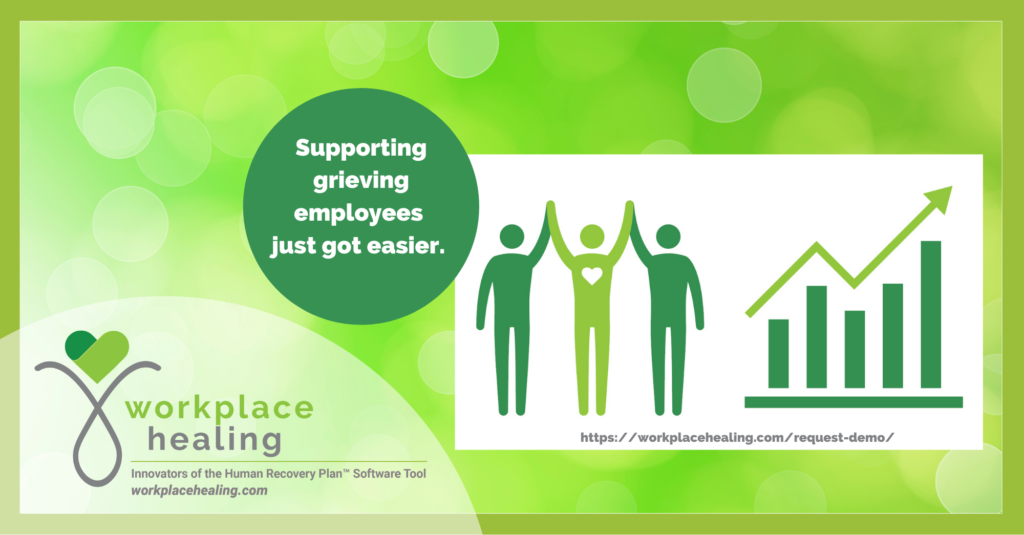
8 Ways Business Leaders Can Support an Employee Grieving a Suicide
When an employee loses a loved one to suicide, they’ll never forget how their employer responded. Learn how to best support your grieving employee while also creating an empathetic work environment that facilitates education and suicide prevention awareness.
Allison Doss had only been in her new job for about six weeks when she came home to discover her 16-year-old daughter Sara had died by suicide. “I didn’t even know who to call at work because I was so new. I ended up contacting a peer and telling my peer to have my boss call me,” Allison says.
Getting a call from your devastated employee to learn that they’ve lost a child or another loved one under tragic circumstances can come as a shock and leave you at a loss for an appropriate response. You may worry about saying or doing the wrong thing and wonder how you can respect your employee’s privacy while also showing you care.
Breaking the stigma.
In our culture, suicide has historically only been discussed behind closed doors and shoved into the shadows, leaving survivors stuck in silent, isolated sorrow. And the stigma prevents those who suffer from depression from seeking treatment.
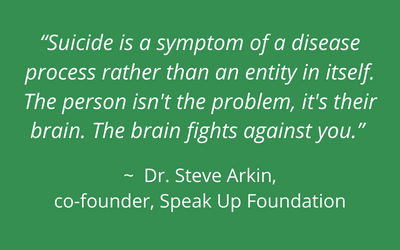 As awareness around mental health grows, more people are beginning to understand that “suicide is one of the symptoms of depression,” says Dr. Steve Arkin, a neurologist whose 20-year-old son Jason, an engineering student at Northwestern University, died by suicide in 2015. “Suicide is a symptom of a disease process rather than an entity in itself. It’s the ultimate symptom, unfortunately. The person isn’t the problem, it’s their brain. The brain fights against you.”
As awareness around mental health grows, more people are beginning to understand that “suicide is one of the symptoms of depression,” says Dr. Steve Arkin, a neurologist whose 20-year-old son Jason, an engineering student at Northwestern University, died by suicide in 2015. “Suicide is a symptom of a disease process rather than an entity in itself. It’s the ultimate symptom, unfortunately. The person isn’t the problem, it’s their brain. The brain fights against you.”
Along with Allison Doss, Steve and his wife Karen (also a neurologist) channeled their grief into a non-profit they founded called Speak Up, which helps teens and their families talk about mental health and the signs of suicide. According to the Centers for Disease Control and Prevention (CDC), suicide is the second leading cause of death among children ages 10-14, the third leading cause of death among young adults ages 15-24, and the 12th leading cause of death in the U.S.
Supporting grieving employees who have lost loved ones to suicide is not only the right thing to do. The more we shine a light on suicide, the more we can do to raise awareness and prevent it.
Eight suicide grief support tips for leaders.
What can you do as a leader to support an employee grieving the loss of a loved one to suicide?
1. Say something.
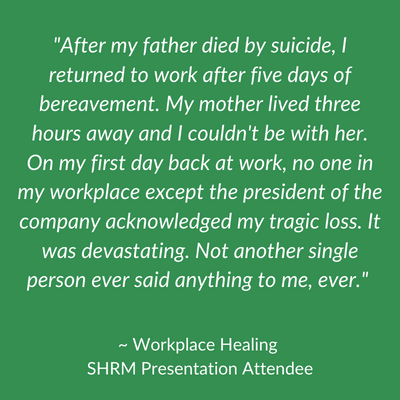 “People are scared of saying the wrong things and because they’re scared of saying the wrong things they won’t say anything at all,” Steve says.
“People are scared of saying the wrong things and because they’re scared of saying the wrong things they won’t say anything at all,” Steve says.
Some things you can say to your employee:
- “I’m so sorry for your loss.”
- “I wish I had the right words, just know I care.”
- “We all need help at times like this. I am here for you.”
Don’t say things like:
- “Be strong.”
- “She brought this on herself.”
- “I know how you feel.”
Encourage your team to join you in expressing condolences, sending a card and/or attending the memorial service/wake.
2. Words matter.
Avoid referring to someone who has died by suicide as having “committed” suicide. Depression is a mental health condition.
“That’s the biggest sticking point in terms of how people talk about it,” Steve says. A person “dies by suicide. Died because of depression with suicide being one of the symptoms of depression.”
While you should always honor your employee’s wishes about how they want to communicate the nature of their loved one’s death with their colleagues, under no circumstances should you make the decision for them.
At Northwestern, one of the administrators informed Steve and Karen that she’d attributed Jason’s death to a seizure to explain his cause of death to others.
“She was trying to protect us from having a kid that died by suicide. We were very disappointed with that approach,” Steve says. Instead, he and Karen chose to be upfront about Jason’s death as a way to educate and build awareness around mental health and suicide prevention. “We could use that information and have Jason be able to talk about (his struggles) through us in a way that’s positive.”
Both the Doss family and the Arkin family experienced their children being called “contagions” by school administrators concerned that if other students became aware of their classmate’s cause of death, they would follow suit. But Steve points out that the research doesn’t support that way of thinking.
Discussing suicide doesn’t lead others to die by suicide. In fact, when information and resources are openly shared and made accessible, we can help prevent suicide. In the workplace, you can lower the risk of suicide and promote employee well-being by:
- Communicating available resources to your team.
- Facilitating opportunities for employee engagement and social connectedness.
- Training your staff to appropriately recognize and respond to the signs of suicide risk.
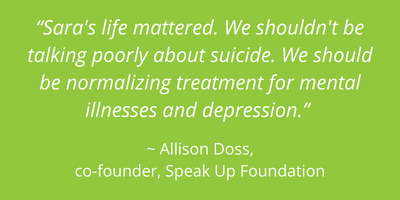 Source: American Psychiatric Association Foundation Center for Workplace Mental Health
Source: American Psychiatric Association Foundation Center for Workplace Mental Health
“Sara’s life mattered. We shouldn’t be talking poorly about suicide. We should be normalizing treatment for mental illnesses and depression,” Allison says.
Ask your employee about how they wish to communicate their loss. Some people may prefer to say that they’d like to focus on their loss rather than the cause of death.
3. Offer empathy and support.
It’s not uncommon for those grieving a suicide, especially parents, to feel a sense of guilt, wondering “what could I/should I have done differently?”
“Karen felt that people would think that we were bad parents to allow this to happen. And even though that’s not true and the disease kind of won in a bad way, that was her fear,” Steve says.
Jason, who had battled depression since age 12, was an exceptionally intelligent and high-achieving young man from a loving and supportive family. “As far as some people were concerned, Jason had everything that he could have wanted,” Steve says. “Why did this still happen? Two neurologists and still your kid died from this? That was the stigma that we thought we were going to run into and we needed to turn it around and that was another reason for starting the Speak Up foundation.”
“It was not our fault that this happened,” Steve says. “You can play that game all the time about who is at fault here, and truly what I believe is the disease is at fault and sometimes the disease wins.”
As an employer, provide a circle of support around your employee so that they don’t feel isolated. Also, promote up-to-date awareness about suicide by sharing education and resources with your staff so that they aren’t perpetuating myths or harmful beliefs about suicide.
4. Say their loved one’s name.
People sometimes worry that they are going to remind the griever of their sorrow by saying the name of the person who died. Grievers are never not thinking about their loved one.
“Some people are afraid of saying the name, but it’s actually helpful because it keeps their memory alive, and in a weird way it keeps him alive,” Steve says. “Jason stood for something. We learned at his funeral that people consulted him about their suicidal thoughts and their battles with mental illness. He turned some people around—at least three people. They said that he saved their lives.”
5. Check in regularly.
Ask your employee if they’d like to talk. They may not and that’s okay. But don’t be afraid to ask again later. If you had known their loved one and can share a favorite memory, do so.
Steve says he welcomed opportunities to talk about his son and made it known from the moment he returned to work. “In general, people who are grieving want to talk about and remember the good times rather than that moment of May 19 (when Jason died),” Steve says.
Allison fondly recalls how her trainer mentor where she worked would frequently check in with her, asking direct questions, like “How can I support you better or differently?” “Do you need a hug?” “Can I get you water/coffee/tea, etc.?”
“I’ll never forget her, her bond and her friendship,” Allison says. “And she showed up for the first Speak Up walk and made sure to find me.”
Instead of saying, “let me know if there is anything I can do,” ask specific questions when you check in with your employee. For example, “We’d like to arrange a meal for you and your family. Does your family have any specific dietary needs/restrictions?”
6. Explain benefits and resources.
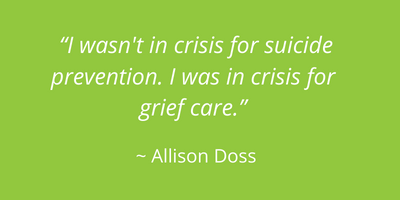 “I couldn’t find any resources when Sara passed,” Allison says. “We spent days trying to figure out where I would go besides checking myself into the hospital. I needed more hands-on therapy sessions. I wasn’t in crisis for suicide prevention. I was in a crisis for grief care.”
“I couldn’t find any resources when Sara passed,” Allison says. “We spent days trying to figure out where I would go besides checking myself into the hospital. I needed more hands-on therapy sessions. I wasn’t in crisis for suicide prevention. I was in a crisis for grief care.”
Don’t assume your grieving employee will reach out to HR. As a manager or employee support liaison, find out what benefits and resources are available to your employee. And keep in mind that your employee will be on emotional and informational overload. Be prepared to remind them about the available benefits as time goes on.
7. Understand the realities.
Because Allison had only just started her job when Sara died, she had no PTO accrued. For the Family Medical Leave Act (FMLA) to kick in, an employee must be on the job for a minimum of a year. Similar to many other companies, paid bereavement leave for an immediate family member at Allison’s workplace only lasted three days. She ended up taking two extra days unpaid.
“My boss was super kind and caring and said to take all of the time you need. But in the back of my mind, I knew that while that was a very generous statement that wasn’t something that was really going to be feasible. My family requires a two-family income so I had to go back to work immediately,” Allison says. “Funerals are expensive and you have to put them on credit cards or pay in one lump sum. And suicide isn’t covered under most policies.”
 Like many grievers, Allison also suffered from brain fog and had trouble remembering things at work which caused her even more stress. “I would write everything down on sticky notes or notebooks and would go back to do whatever tasks they needed me to do and just be completely lost.”
Like many grievers, Allison also suffered from brain fog and had trouble remembering things at work which caused her even more stress. “I would write everything down on sticky notes or notebooks and would go back to do whatever tasks they needed me to do and just be completely lost.”
Learn more about an employee’s brain on grief.
8. Make accommodations to re-engage your employee.
When your employee returns to work, find out what would be most supportive for them. Are there tasks that can be taken off of their plate temporarily? Would it help to work four 10-hour days with Fridays off? Is a hybrid option available where the employee could split their time between the office and home? If the grieving employee doesn’t have enough PTO or paid bereavement leave, is it possible for colleagues to donate an hour or two of their PTO to the griever?
“Being in the office was super hard for me because I felt like everybody was staring at me,” Allison says, who suffered from severe PTSD following Sara’s death. Surrounded by her co-workers and rows of connected desks, she became ultra-sensitive to the noises and movements around her, which would trigger her trauma. “I needed to be in a quiet room.” But it didn’t occur to her to ask for an accommodation until her therapist suggested it.
“If there is one message I would give to anybody in HR, it would be don’t make us go searching for an answer,” Allison says.
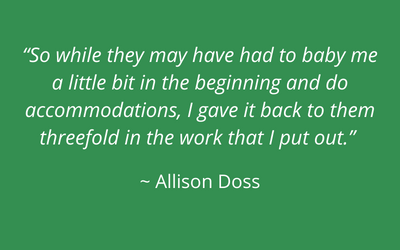 Although there were many things Allison’s employer was unable to do because of policy restrictions, she says they treated her with kindness and generosity each step of the way. They were able to accommodate many of her requests like allowing her to work from home and using a quiet conference room when she was in the office. They also accommodated her therapy appointments each week.
Although there were many things Allison’s employer was unable to do because of policy restrictions, she says they treated her with kindness and generosity each step of the way. They were able to accommodate many of her requests like allowing her to work from home and using a quiet conference room when she was in the office. They also accommodated her therapy appointments each week.
Allison stayed for five years and received two promotions during that time. “So while they may have had to baby me a little bit in the beginning and do accommodations, I gave it back to them threefold in the work that I put out.”
Help is available.
Are your employees at risk for suicide? Check out the article “How to Spot Suicidal Behaviors in the Workplace” by Matt Gonzales, SHRM.
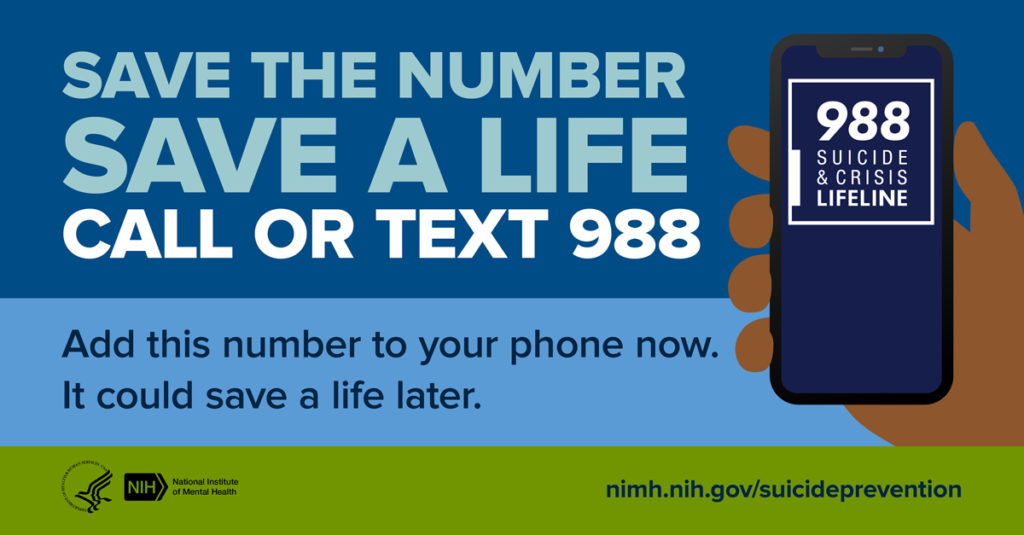 *For anyone experiencing suicidal thoughts or struggling in crisis, call or text 988 or chat 988lifeline.org to be connected with a trained crisis counselor.
*For anyone experiencing suicidal thoughts or struggling in crisis, call or text 988 or chat 988lifeline.org to be connected with a trained crisis counselor.
Eliminate the guesswork.
Know how to respond to a grieving employee with confidence. Supporting an employee through grief doesn’t have to be difficult or awkward. We can help. Schedule a demo to learn more about Workplace Healing’s Human Recovery Platform™.
